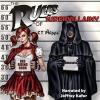Okay, so here we go....
License Renewedby John Gardner (Jonathan Cape, 1981)Reviewed by Ryan HarveyAfter a literary silence of thirteen years (if you don't count John Pearson's 1973 "biography"), James Bond returned in 1981 in a splashy way. Glidrose Ltd., the literary rights-holders to the character, offered the writing reins to popular British spy novelist John Gardner and gave him a free hand to re-invent and update 007 for the 1980s.
Glidrose's choice of Gardner to carry on Ian Fleming's legacy is, in retrospect, a strange one. John Gardner's most high-profile espionage books at the time, the comedic stories of the cowardly Boysie Oakes, are as far removed as possible from Fleming's world of fantasy violence while still staying in the thriller genre. Gardner would later admit on his website that when he accepted the assignment he had no particular fondness for the Ian Fleming Bond books. His writing style shows no obvious reverence for the Fleming mixture of journalism and feverish subjectivity, and the changes he wrought on Bond himself moved the classic spy far from his creator's original and darker portrait. Gardner's Bond was "clean-scrubbed" for a new era and an audience consistently conditioned by the movies, particularly the popular Roger Moore fantasies. On the other hand, Gardner had no love of the movies either and refused to watch any of them once he started his tenure as Bond's amanuensis. (This means that the last Bond movie he saw was
Moonraker, which has all sorts of disturbing implications.)
However, Gardner's notable anti-qualifications as the official Bond writer may have helped him in his early days on the series. The separation from the Fleming tradition assures that, whatever other flaws it might have,
License Renewed feels different and fresh. Renewed, if you will. It doesn't try to imitate the style of the original novels and additionally incorporates the more action-fantasy elements of the movies. But it also toughens Bond's image compared to the light-stepping Roger Moore version. For 1981,
License Renewed landed in a perfect comfort zone, and readers responded with high sales. John Gardner was accepted, and over the next fifteen years (during the tenure of
three Bond actors) he would write an additional thirteen original James Bond adventures, plus two novelizations.
The enthusiasm in
License Renewed, the feeling of something new, makes it one of Gardner's more enjoyable Bonds. His comfort level with the character and execution of pacing would improve in the books that immediately followed it (reaching a peak with
Nobody Lives Forever), but his first adventure still holds up as an enjoyable summer read. It falls on the cinematic side of the 007 bell-curve, a quality it shares with the other early Gardners before the gap between the writer and the continuing Eon film series grew too great.
The opening chapters don't get the book off to a promising start. The first chapter describes a man changing into a disguise in the men's restroom of the Dublin airport, but this builds up to nothing. The mysterious figure isn't James Bond, nor is he about to commit a dastardly crime or assassination. Moving on to the next chapter after this limp first shot, Gardner lays out his "Bond '81" plan to lift the character from the 1960s and into the 1980s without aging him. Chapter two outlines all these changes: a new car, a new cottage, a stripped-down secret service without a double-o section, and Bond coming off a period of espionage inertia and eager to work as her majesty's "blunt instrument" again. This is a new James Bond, the author tells us, and then divulges details that might have been more interesting had he sprinkled them throughout the first half of the book instead of unloading them in the second chapter. Perhaps both Gardner and Glidrose felt nervous about the experiment and wanted to answer all their readers' questions about the update at the outset. Getting Bond into action quicker would have done the job more neatly. Don't give the audience too much time to think: hook 'em!
The standard MI6 briefing chapters follow, then a ludicrously silly gizmo-laden dalliance with new continuing character "Q'ute" (a.k.a. Ann Reilly of Q Branch), before the story proper finally gets underway in the sixth chapter. Getting through the pointless scene with Q'ute will tax a few readers--it is easily the worst sequence in the book--but the story has nowhere to go but up after this, and it rises fast. After the false-start opening, the rest of
License Renewed is the romp the heated book jacket blurb promises, with escapes, subterfuge, fisticuffs, an assassination attempt, torture, a car chase, and a thrilling aerial climax. Gardner leaps into the fray with a Bond neophyte's enthusiasm that is sadly absent from his many later tales of 007.
Bond gets to go "home," in a way: the hills of Scotland. M sends his top agent to investigate the meetings between the infamous terrorist Franco and Anton Murik, a Scottish laird and one of the world's leading nuclear physicists. Bond first makes contact with Murik at the Ascot Gold Cup race, the most Fleming-esque section in the book and one that would suspiciously appear in the movie
A View to a Kill a few years later. Bond uses Murik's lovely young ward, Lavendar Peacock, to get an introduction to the laird. Posing as a mercenary looking for a job, Bond receives an invitation to Murik's castle in Murcaldy, Scotland. Of course once 007 gets there, he discovers that the laird, who is enraged that the International Atomic Energy Commission rejected his "ultra-safe" nuclear reactor design, is Up To No Good. But can James Bond escape in time to warn the world governments of the impending danger, and also rescue Lavendar Peacock from her dangerous guardian? We know the answers to both questions, of course, but getting to the answers is an enjoyable time.
Anton Murik, the ersatz Laird of Murcaldy (much like Blofeld is the ersatz Comte de Bleauchamp), is a serviceable if unoriginal villain in the megalomaniacal independent billionaire category. His ambition to save the world through terrorist actions put him firmly in the camp of the movie villains Karl Stromberg and Hugo Drax; his physical description even resembles that of Kurt Jurgens, the actor who plays Stromberg in
The Spy Who Loved Me. (If Anton Murik were cast today, Terence Stamp would be perfect for the part.) More effective than Murik are two of the secondary villains, Mary Jane Mashkin and Caber. Mashkin is Murik's assistant and possible mistress, but unlike other
femme fatales Bond isn't attracted to her and resists her advances. As an icy manipulator, she works well. Standard big thug Caber speaks in a stereotypical highland lingo, but makes for a tough and dangerous brute and a consistent menace. He comes to a more exciting end than his master.
Lavendar Peacock is a trembling innocent Bond-girl who falls for Bond in a heartbeat and then helps him out against Murik. She isn't a terribly suspenseful or dramatic character, but she never distracts too much from the forward progression of events. The specifics of her relationship to Anton Murik and his inheritance are given short shrift and never properly worked into the plot. Murik explains it hastily in the middle of a batch of other exposition, and by that point Bond has plenty of other worries.
Bond does not remain undercover at Murik's castle for too long, and once he tries to make an escape from the fortress to send word to M about Murik's plan for nuclear blackmail, the action shifts into high and stays there the rest of the way. Some of the action will cause
d
Edited by Double-O Eleven, 11 October 2006 - 05:11 PM.




